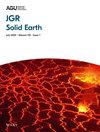Evidence for an Upper Crustal Melt Lens Beneath Tianchi (Changbaishan) Volcano
IF 3.9
2区 地球科学
Q1 GEOCHEMISTRY & GEOPHYSICS
引用次数: 0
Abstract
Changbaishan volcanic field (CBVF) located on the border of China and the Democratic People's Republic of Korea (DPRK) is famous for intense volcanism in the Cenozoic. Many studies show evidence for partial melt beneath the volcano, but details on the structure of the magmatic system are lacking, due to a lack of data in the region. In this study, we obtained a high-resolution crust and upper mantle shear wave velocity (Vs) model beneath the CBVF by ambient noise tomography and receiver functions using a new dense seismic array. The absence of velocity anomalies beneath Wangtian'e and Namphothe volcanoes suggests a lack of magma within the crust. However, our models reveal two low Vs anomalies beneath Tianchi associated with magma reservoirs. The shallow low velocity anomaly (<4 km) overlaps with petrological estimates of the assembly depth of erupted rhyolite magma reservoir and the depth inferred for a hydrothermal reservoir from a recent MT study. The deeper one is located between 7 and 14 km depth with a lateral extent of ∼30 km, with a melt fraction of ∼6%–12%. Underlying the deeper low velocity zone in the lower crust is a region of faster velocity compared to the surrounding region. We interpret this as a low melt fraction crystal mush. This structure is similar to that seen at other large caldera volcanoes worldwide, suggesting a possible common mechanism underlying magmatism at these volcanoes.天池(长白山)火山下上部地壳熔融透镜的证据
长白山火山田位于中国与朝鲜交界地带,以其新生代强烈的火山活动而闻名。许多研究显示了火山下部分融化的证据,但由于该地区缺乏数据,缺乏岩浆系统结构的细节。在这项研究中,我们利用一种新的密集地震阵列,通过环境噪声层析成像和接收函数获得了CBVF下高分辨率的地壳和上地幔横波速度(Vs)模型。王天娥火山和南phothe火山下没有速度异常表明地壳内缺乏岩浆。然而,我们的模型揭示了天池地下与岩浆储层有关的两个低v异常。浅层低速异常(<4 km)与岩石学估计的喷流纹岩岩浆储层组合深度和最近MT研究推断的热液储层深度重叠。较深的位于7 ~ 14 km深度之间,横向范围为~ 30 km,熔体分数为~ 6% ~ 12%。下地壳中较深的低速带下面是一个比周围区域速度更快的区域。我们将其解释为低熔体分数晶体糊状物。这种结构与世界上其他大型破火山口火山的结构相似,表明这些火山的岩浆活动可能存在共同的机制。
本文章由计算机程序翻译,如有差异,请以英文原文为准。
求助全文
约1分钟内获得全文
求助全文
来源期刊

Journal of Geophysical Research: Solid Earth
Earth and Planetary Sciences-Geophysics
CiteScore
7.50
自引率
15.40%
发文量
559
期刊介绍:
The Journal of Geophysical Research: Solid Earth serves as the premier publication for the breadth of solid Earth geophysics including (in alphabetical order): electromagnetic methods; exploration geophysics; geodesy and gravity; geodynamics, rheology, and plate kinematics; geomagnetism and paleomagnetism; hydrogeophysics; Instruments, techniques, and models; solid Earth interactions with the cryosphere, atmosphere, oceans, and climate; marine geology and geophysics; natural and anthropogenic hazards; near surface geophysics; petrology, geochemistry, and mineralogy; planet Earth physics and chemistry; rock mechanics and deformation; seismology; tectonophysics; and volcanology.
JGR: Solid Earth has long distinguished itself as the venue for publication of Research Articles backed solidly by data and as well as presenting theoretical and numerical developments with broad applications. Research Articles published in JGR: Solid Earth have had long-term impacts in their fields.
JGR: Solid Earth provides a venue for special issues and special themes based on conferences, workshops, and community initiatives. JGR: Solid Earth also publishes Commentaries on research and emerging trends in the field; these are commissioned by the editors, and suggestion are welcome.
 求助内容:
求助内容: 应助结果提醒方式:
应助结果提醒方式:


